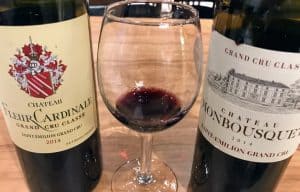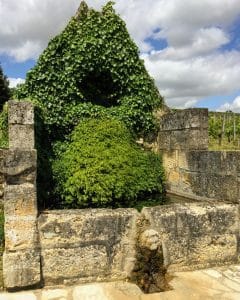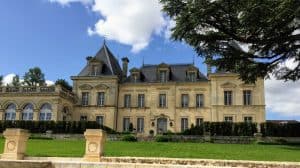
For our next installment on the 2017 Bordeaux Futures campaign, we go to St. Emilion to look for values from the sister properties of the Premier Grand Cru Classe estates Ch. Canon-la-Gaffeliere and Ch. Cheval Blanc as well as the Grand Cru Classe estates of Ch. Monbousquet and Ch. Fonplegade.
To see some of the our previous posts on the 2017 campaign check out:
Bordeaux Futures 2017 — Palmer, Valandraud, Fombrauge, Haut-Batailley
Bordeaux Futures 2017 — Pape Clément, Ormes de Pez, Marquis d’Alesme, Malartic-Lagraviere
Bordeaux Futures 2017 — Lynch-Bages, d’Armailhac, Clerc-Milon and Duhart-Milon
Now onto the offers.
Clos de l’Oratoire (St. Emilion)
Some Geekery:
The history of Clos de l’Oratoire dates back to the 1800s when it was part of the large estate of Château Peyreau on the northeast slope of the St. Emilion plateau. In 1874, Edouard Féret ranked the Peyreau estate as one of “second growth quality.”
When the vineyards of St. Emilion were classified in 1955, the best sections of Peyreau were splintered off and became Clos de l’Oratoire. This new estate was ranked as a Grand Cru Classé while Ch. Peyreau would be bottled under the St. Emilion Grand Cru AOC.

The label of Clos de l’Oratoire and many other wines in the portfolio of Vignobles Comtes von Neipperg prominently feature the family’s coat of arms that date back to the early 1700s.
In the 1970s, both Peyreau and Clos de l’Oratoire where purchased by the von Neipperg family with the estates joining a portfolio that now includes the Premiers Grands Cru Classé ‘B’ estates of Ch. Canon-La-Gaffeliere and La Mondotte, Ch. d’Aiguilhe in Cotes de Castillon, Clos Marsalette in Pessac-Léognan (jointly owned with Didier Miqueu), the Sauternes Premier Cru Ch. Guiraud, Capaia in the New Philadelphia region of South Africa and Bessa Valley in Bulgaria.
All the vineyards are farmed sustainably with some parcels biodynamically managed.
The 2017 vintage is a blend of 90% Merlot and 10% Cabernet Franc.
Critic Scores:
93-94 James Suckling (JS), 90-92 Wine Advocate (WA), 89-92 Wine Spectator (WS), 90-93 Vinous Media (VM), 90-92 Jeb Dunnuck (JD), 90-92 Jeff Leve (JL)
Sample Review:
The 2017 Clos de l’Oratoire is pliant and supple, with striking balance of fruit and tannin. In some recent vintages, Clos de l’Oratoire has been more massive, but I have to say, the balance of the 2017 is really quite compelling. A rush of red cherry, plum, blood orange, pomegranate and mint builds into the racy, pliant finish. This is a gorgeous vintage for Clos de l’Oratoire. Sadly, yields are down by 60% because of frost on the lower parts of the vineyard. As a result, only hillside parcels were used. Tasted two times. — Antonio Galloni, Vinous Media
Offers:
Wine Searcher 2017 Average: $35
JJ Buckley: No offers yet.
Vinfolio: No offers yet.
Spectrum Wine Auctions: No offers yet.
Total Wine: $39.97 (no shipping with wines sent to local Total Wine store for pick up)
K & L: $37.99 +shipping (no shipping if picked up at 1 of 3 K & L locations in California)
Previous Vintages:
2016 — Wine Searcher Ave. $43 Average Critic Score: NA
2015 — Wine Searcher Ave. $50 Average Critic Score: 91 points
2014 — Wine Searcher Ave. $40 Average Critic Score: 90
2013 — Wine Searcher Ave. $32 Average Critic Score: 89
Buy or Pass?
Clos de l’Oratoire benefits from the same winemaking and viticultural teams as the blockbuster estates of Canon-La-Gaffeliere (Wine Searcher Ave $95) and La Mondotte (Wine Searcher Ave $252). While Clos de l’Oratoire will never reach the depths and pure hedonistic pleasures of those wines, I’ve always found it be a solid “baby brother” and good value.

While I certainly do enjoy nice Napa wines, getting a lush but elegant “New World-ish” Bordeaux like Clos de l’Oratoire for almost half the price is a stellar value.
In general, I find the wines of von Neipperg and his consultant Stéphane Derenoncourt to be very “New Worldish” and Napa-like meant for more short-term consumption. For a vintage like 2017 which I’m not planning on cellaring long that makes Clos de l’Oratoire a compelling buy–especially when I compare it to Napa wines in similar price points. I would put the quality of Clos de l’Oratoire on par with Napa Cabs like Silver Oak and Duckhorn or Merlots like Pride and Barnett Vineyards which all easily fetch far more than $40 a bottle. That makes this wine an easy Buy for me.
Ch. Monbousquet (St. Emilion)
Some Geekery:
First owned by François de Lescours in 1540, Monbousquet spent almost 150 years under the stewardship of the notable De Carles family who also owned Château de Carles in Fronsac and were very prominent in Bordeaux politics from the 15th to 17th centuries.
The modern history of Monbousquet began in 1993 when the estate was purchased by Gerard Perse who brought in Michel Rolland as a consultant. While Perse would go on to acquire the Premier Grand Cru Classe ‘A’ Ch. Pavie, Grand Cru Classé Ch. Pavie Decesse and St. Emilion Grand Cru Chateau Bellevue Mondotte as well as Clos Lunelles in the Cotes de Castillon, the chateau of Monbousquet would be the Perse family’s personal home until 2013 when it was sold to a French pension fund.

Ch. Monbousquet in the early 1900s.
Since 2006 the estate has been ranked as Grand Cru Classé with around 6000 cases a year produced. During the years of Perse’s ownership the percentage of Cabernet Franc and Cabernet Sauvignon was steadily increased in the more gravel and sand portions of the vineyards and today the estate is planted to around 60% Merlot, 30% Cabernet Franc and 10% Cabernet Sauvignon.
Critic Scores:
92-94 Wine Enthusiast (WE), 92-93 JS, 89-92 WS, 89-91 WA, 90-91 JL, 90-92 JD
Sample Review:
Incense, red cherries, thyme and smoke open the wine. On the palate, the wine is medium-bodied, full, velvety, polished and forward. The fruit is bright and you sense true freshness. The percentage of new oak has dropped to 50%, placing the fruit center stage. — Jeff Leve, The Wine Cellar Insider
Offers:
Wine Searcher 2017 Average: $52
JJ Buckley: No offers yet.
Vinfolio: No offers yet.
Spectrum Wine Auctions: $311.94 for minimum 6 pack + shipping (no shipping if picked up at Tustin, CA location)
Total Wine: $54.97
K & L: No offers yet.
Previous Vintages:
2016 — Wine Searcher Ave. $54 Average Critic Score: 89 points
2015 — Wine Searcher Ave. $60 Average Critic Score: 91
2014 — Wine Searcher Ave. $50 Average Critic Score: 90
2013 — Wine Searcher Ave. $44 Average Critic Score: 89
Buy or Pass?

While the 2012 Monbousquet is still a terrific value, I’ve been far more impressed with the efforts of many other St. Emilion estates (like Fleur Cardinale) in 2014 and 2015 for similar price points. That experience is encouraging me to take a “wait and see” approach to future Monbousquet releases.
I used to adore Monbousquet and have been avidly consuming vintages since 2005. While I’m still buying and getting a lot of pleasure from the 2012 vintage (Wine Searcher Average $55), I must confess that both the 2014 and 2015 underwhelmed me–especially for their price points.
While the 2012 was undoubtedly blended and bottled under the new winemaking team following the 2013 sale, I’m still a bit skeptical that Monbousquet is going to continue to be the reliable pleasure producer that it was for so many years under the Perse family’s stewardship. For a vintage like 2017 that skepticism is enough to merit a Pass for me.
Ch. Quinault l’Enclos (St. Emilion)
Some Geekery:
Historically part of the satellite region Sables St. Emilion that surrounded the city of Libourne, Quinault l’Enclos was often overlooked until 1997 when it was purchased by Alain Raynaud.
Raynaud renovated the cellars and replanted many under-performing parcels by the time he sold the estate in 2008 to Bernard Arnault and Albert Frere, the owners of the legendary Cheval Blanc. Today the vineyards and winemaking of the Grand Cru Classé is managed by Pierre Lurton with the same team used at Cheval Blanc. Since 2009 all vineyard parcels have been farmed organically.
Under Lurton and the Cheval Blanc team the percentage of Cabernet Sauvignon and Cabernet Franc used in the final blend has steadily increased with the 2017 vintage being a blend of 62% Merlot, 22% Cabernet Sauvignon and 16% Cabernet Franc. Around 7500 cases are made yearly.
Critic Scores:
92-93 JS, 90-92 WE, 89-91 VM, 89-91 WA, 88-90 JL
Sample Review:
The Cheval Blanc team changed everything when they started working there 10 years ago. Replanting with good clones etc and more Cabernet Sauvignon because there is a lot of gravel. Now also a new cellar, concrete for fermentation. Experimenting with foudres and bigger 500-litre barrels to reduce the oak impact but all new.
Deep crimson. Delicately herbaceous and slightly dusty aroma. Smells of stone dust. Or is it the concrete in the cellar? Under that, light cassis. Strange mix of herbaceous flavours and sweet chocolate. Sweet/sour at the moment. Smooth tannins, chocolate texture. Gentle but fresh.(16 out of 20) — Julia Harding, JancisRobinson.com
Offers:

Being managed by the same viticultural and winemaking team as the illustrious Cheval Blanc (pictured) makes Quinault L’Enclos a compelling value for under $35 a bottle.
Wine Searcher 2017 Average: $31
JJ Buckley: No offers yet.
Vinfolio: No offers yet.
Spectrum Wine Auctions: No offers yet.
Total Wine: $33.97
K & L: No offers yet.
Previous Vintages:
2016 — Wine Searcher Ave. $ 36 Average Critic Score: NA
2015 — Wine Searcher Ave. $ 44 Average Critic Score: 92 points
2014 — Wine Searcher Ave. $ 35 Average Critic Score: 90
2013 — Wine Searcher Ave. $ NA Average Critic Score: NA
Buy or Pass?
Quinault L’Enclos first caught my attention with its savory and elegant 2010 vintage. While that vintage today averages around $50 (which is still a good value for its quality), it was a raging steal of a deal a few years back when it was around $35-40. The estate continued to impressed me with very solid offerings in the troublesome vintages of 2011 and 2012 and has been drinking fantastic for a young 2015.
Even though it has been under the Cheval Blanc teams stewardship for almost 10 years, this estate is still vastly underrated and is truly a gem worth discovering. As you can tell by the dearth of retail offers, this is a tough wine to get in the US (though I’ve noticed an uptick in savvy sommeliers putting this on restaurant wine lists), it’s worth finding and nabbing a few bottles if you can–especially the 2015 that is out in the market now.
Eventually folks are going to catch on and the prices will rise to match the quality but for under $50 this is a no-brainer Buy for me.
Ch. Fonplegade (St. Emilion)
Some Geekery:
Home to ancient Roman ruins that date back to AD 400, Fonplegade is one of the oldest and most historical properties in Bordeaux. The Roman settlement of St. Emilion likely took advantage of the fountain that still sits among the vines in the vineyard. The name “Fonplegade” itself roughly translates to “flowing fountain” or “fountain of plenty”.
The chateau was built in the 1850s and by 1863 the estate came under the ownership of Napoleon III’s step-brother, Charles de Morny the Duke of Morny. In 1953, the Moueix family (of Petrus fame) purchased Fonplegade. The property stayed in the family for several decades until 2004 when Armand Moueix sold it to Americans Denise and Stephen Adams.

The fountain in the vineyards of Fonplegade.
The Adams hired Michel Rolland as a consultant and began converting the vineyards over to organic and biodynamic (a similar path they took with the Pomerol estate they purchased in 2006, Ch. L’Enclos). By 2013, Fonplegade was certified organic with aims of being fully certified biodynamic by 2020. In 2015 Stephane Derenoncourt was hired to replace Rolland as consulting winemaker working with Corinne Comme the wife of Pontet-Canet’s Jean-Michel Comme.
In 2010, all the Cabernet Sauvignon vines were removed and replaced with Cabernet Franc. Sensing the potential of the variety in their clay and limestone dominant soils, the Adams have a goal of eventually 20% of the vineyard being planted to the grape.
The 2017 vintage is a blend of 90% Merlot and 10% Cabernet Franc. Around 4000 cases a year are produced.
Critic Scores:
93-95 WA, 92-94 VM, 92-93 JS, 90-93 WS, 93-95 JL, 90-92 JD
Sample Review:
The deep garnet-purple colored 2017 Fonplegade has quite a spicy nose sporting notes of anise, cloves, fenugreek and black pepper over a core of warm black plums and blackberries plus a waft of potpourri. Medium-bodied with a rock-solid frame of grainy tannins and wonderful freshness, it features bags of vibrant black fruits and a long, spicy finish. — Lisa Perrotti-Brown, Wine Advocate
Offers:

Ch. Fonplegade in 2011 before work to reconstruct the right tower that was damaged in World War II began.
Wine Searcher 2017 Average: $34
JJ Buckley: $35.94 + shipping (no shipping if picked up at Oakland location)
Vinfolio: No offers yet.
Spectrum Wine Auctions: No offers yet.
Total Wine: $34.97
K & L: No offers yet.
Previous Vintages:
2016 — Wine Searcher Ave. $ 38 Average Critic Score: 92 points
2015 — Wine Searcher Ave. $ 50 Average Critic Score: 91
2014 — Wine Searcher Ave. $40 Average Critic Score: 89
2013 — Wine Searcher Ave. $35 Average Critic Score: 89
Buy or Pass?

Fonplegade in 2016 after the right tower was restored. Beginning with the 2015 vintage you can see the two towers illustrated on the wine’s label.
Visiting the estate of Ch. Fonplegade was one of the highlights of my 2016 trip to Bordeaux and it is clear that the Adams family are dedicated to raising the profile and quality level of the property. Touring the vineyards and their immaculate winery you could tell that no expense was being spared in their quest. Along with Ch. Fleur Cardinale, Fonplegade is one of the Grand Cru Classé that I can see eventually being promoted to Premier Grand Cru Classé ‘B’.
I am intrigued with the change from Rolland to Derenoncourt as I tend to prefer the later’s style a bit more. I’m also quite pleased at the very reasonable pricing for the futures being noticeably less than the current market prices for the 2014 and 2015. With value seeking being a primarily driver in my approach to the 2017 vintage this puts Fonplegade as a solid Buy for me.
More Posts About the 2017 Bordeaux Futures Campaign
*Bordeaux Futures 2017 — Langoa Barton, La Lagune, Barde-Haut, Branaire-Ducru
*Bordeaux Futures 2017 — Pape Clément, Ormes de Pez, Marquis d’Alesme, Malartic-Lagraviere
*Bordeaux Futures 2017 — Lynch-Bages, d’Armailhac, Clerc-Milon and Duhart-Milon
*Bordeaux Futures 2017 — Cos d’Estournel, Les Pagodes des Cos, Phélan Ségur, Calon-Segur
*Bordeaux Futures 2017 — Clinet, Clos L’Eglise, L’Evangile, Nenin
Bordeaux Futures 2017 — Malescot-St.-Exupéry, Prieuré-Lichine, Lascombes, Cantenac-Brown
*Bordeaux Futures 2017 — Beychevelle, Talbot, Clos du Marquis, Gloria
*Bordeaux Futures 2017 — Beau-Séjour Bécot, Canon-la-Gaffelière, Canon, La Dominique
*Bordeaux Futures 2017 — Vieux Chateau Certan, La Conseillante, La Violette, L’Eglise Clinet
*Bordeaux Futures 2017 — Montrose, La Dame de Montrose, Cantemerle, d’Aiguilhe
*Bordeaux Futures 2017 — Clos Fourtet, Larcis Ducasse, Pavie Macquin, Beauséjour Duffau-Lagarrosse
*Bordeaux Futures 2017 — Kirwan, d’Issan, Brane-Cantenac, Giscours
